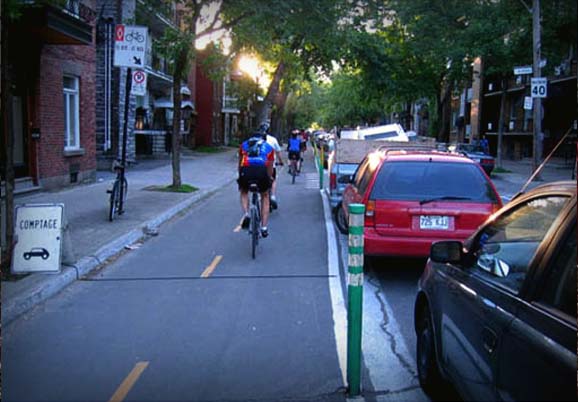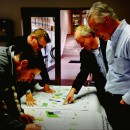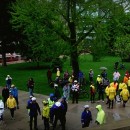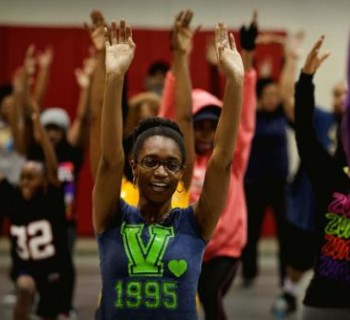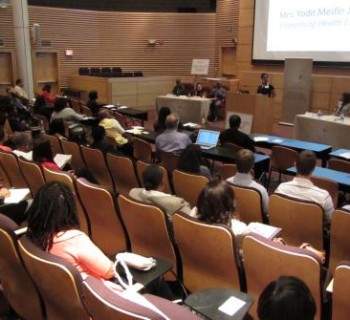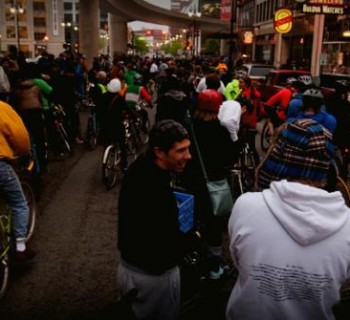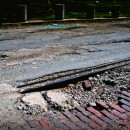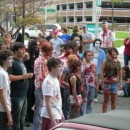DETROIT—With 16 bike lane miles in the Corktown-Mexicantown Greenlink, 2.5 greenway miles along the Detroit Riverfront , the 1.35-mile Dequindre Cut connecting the riverfront with Eastern Market, and many, many more bike lanes and greenways planned or under construction, it would seem Detroit is bike-friendlier than ever.
The city boasts the Tour de Troit, the state’s largest annual organized bike event, in addition to a slew of other community rides like Slow Roll, Detroit Progressive Dinner Rides, and more. In the past several years, the city has seen the rise of local bike manufacturing, the adoption of a city policy that allows bikes on buses and trains, and the endorsement of Talking Heads’ singer and cycling advocate David Byrne. So why did the League of American Bicyclists reject the City of Detroit’s 2012 application for recognition as a “Bicycle-Friendly Community?”
The answer is simple: they are asking the wrong questions for a city like Detroit. That’s according to Todd Scott, Detroit Greenways Coordinator with the Michigan Trails and Greenways Alliance, who wrote the application. The League recognizes more than 250 cities in the United States and Canada with Platinum, Silver, Gold and Bronze ratings. In Michigan, Ann Arbor has a silver rating; Grand Rapids, Marquette, Midland, Portage, Lansing, Traverse City and Houghton have bronze ratings. The City of Detroit’s application received an “honorable mention.”
Communities are evaluated based on a variety of factors including municipal resources spent on bicycle programming, infrastructure, and maintenance, bicycle activism and public education efforts, bike-friendly regulations, and bike safety. The designation is useful to communities as a marketing tool and to help identify ways to improve.
But according to Scott, Detroit may never fit into the League’s one-size-fits-all framework. “For a lot of the questions they ask, our answers look terrible,” he says. In the application, Scott wrote detailed essay responses explaining why the city should be recognized for meeting or exceeding the spirit, if not the letter, of the League’s expectations. For example, the League places a heavy emphasis on municipal leadership and management, detracting points for not having a full-time, municipal employee dedicated to the local bicycle program - something that’s a little tough for a municipality undergoing bankruptcy.
“What they wouldn’t count is all of the nonprofit employees we have doing the job that municipal employees might do in other cities,” says Scott. “Detroit certainly is the outlier when it comes to the government’s role. We rely a lot on private funding, which doesn’t get captured well in the League’s survey.”
While the City of Detroit allocates about 25-50 percent of one city traffic engineer’s time to cycling, about 30 full-time equivalent employees are working in various nonprofits to push the cycling agenda across the city, according to Scott.
Another area where Detroit came up short was in miles of bike lanes. The League does not recognize Detroit’s greatest cycling amenity: it’s wide, low-traffic roadways. “That’s our biggest asset; all of our roads are bike friendly,” says Scott. “We joke that we don’t have many bike lanes because we have car lanes to use.”
John Lindenmayer, Advocacy & Policy Director for the League of Michigan Bicyclists, says Detroit is one of the most bicycle-friendly cities in the state.
“The City continues to do a wonderful job expanding its network of bike lanes and greenways and has a bicycle culture truly unlike elsewhere in the country,” says Lindenmayer. “Anytime you have an outside entity evaluate a community, they are going to do so through their own lens, which can often be rigid and not always take in consideration the unique aspects of a community.
Leah Groya, a planner with livingLAB who has worked on bike and greenways projects in the city and across the state, sees some value in the League’s framework. “Like with any rating system, there are arguments about the finer points,” says Groya. “It’s a starting point, and it raises public awareness. It can be a nice thing if promoted well.”
So what does Detroit need to be more bike-friendly?
Scott identified three top priorities: adopting a Complete Streets Ordinance, establishing a bike connection between Detroit and Windsor (a Bronze city), and revising Detroit’s traffic ordinance to better comply with the Uniform Vehicle Code, which is friendlier to cyclists.
None of this may be enough to get the League’s recognition, which is OK with Scott. “Even if we were to get the designation, it wouldn’t be accurate,” says Scott. “I think our best option at this point is to be the outlier and the underdog, and to seek other ways for getting recognition.”
Is the League right? And, do you agree with Todd Scott's agenda for cycling in the city? Attend our event Thursday to discuss.


